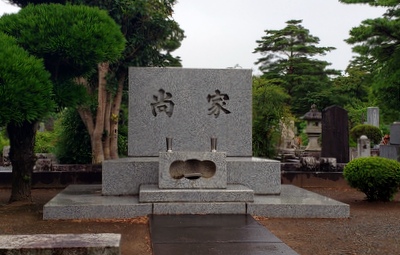Difference between revisions of "Sho Jun (1873-1945)"
| (4 intermediate revisions by the same user not shown) | |||
| Line 1: | Line 1: | ||
| + | [[File:Sho Jun1918.jpg|right|thumb|400px|Shô Jun in a 1918 photograph of the family.]] | ||
| + | [[File:Grave-sho-jun.jpg|right|thumb|400px|Grave of Shô Jun in Tama Cemetery, Tokyo]] | ||
*''Born: [[1873]]/4/6'' | *''Born: [[1873]]/4/6'' | ||
*''Died: 1945/6/16'' | *''Died: 1945/6/16'' | ||
| Line 13: | Line 15: | ||
In his later years, he managed the Tôbaru Plantation in [[Shuri]], and created a tropical botanical garden on Gogayama in [[Nakijin]]. He became known as a man of culture and refinement in many fields of interest and as a calligrapher as well. | In his later years, he managed the Tôbaru Plantation in [[Shuri]], and created a tropical botanical garden on Gogayama in [[Nakijin]]. He became known as a man of culture and refinement in many fields of interest and as a calligrapher as well. | ||
| − | Shô Jun | + | Shô Jun died during the Battle of Okinawa in 1945. According to [[Yamazato Eikichi]], he opted not to evacuate from Okinawa due to his advanced age, the danger of the sea journey, and other factors. He fled south, as many people did, as the battle enveloped the central portions of [[Okinawa Island]]; lacking for food, he died of starvation or illness.<ref>Yamazato Eikichi 山里永吉, "Ryukyu kara Kyoto he," ''Mingei'' 70 (July 1945), 18.; Yamazato, "Yamazato Eikichi" 「山里永吉」, ''Watashi no sengoshi'' 『私の戦後史』, vol. 2, Okinawa Times (1980), 93.</ref> His children included [[Sho Sen|Shô Sen]] (尚詮, 1926-1990), whose wife [[Sho Hiroko|Shô Hiroko]] (b. 1932) is perhaps the most prominent member of the Shô family alive today. |
==References== | ==References== | ||
Latest revision as of 07:14, 28 August 2025
- Born: 1873/4/6
- Died: 1945/6/16
- Titles: Member of the House of Peers (帝国議会議員, Teikoku gikai giin), 松山王子 (Prince Matsuyama)
- Other Names: 鷺泉 (Rosen)
- Japanese: 尚 順 (Shou Jun)
Shô Jun was a prince of the Kingdom of Ryûkyû, the fourth son of King Shô Tai, the last king of the kingdom. He played a major role in founding many 20th century institutions in Okinawa, including the Ryûkyû Shimpô newspaper in 1893, the Bank of Okinawa, the Taishô Gekijô theater, and a canning factory, and was a major figure in both the Japanese political and investment worlds of his time.
Following the abolition of the kingdom in 1879, Shô Jun, along with the rest of the Ryukyuan royal family, was made a noble in the new Japanese kazoku system of peerage. His father, King Shô Tai, was made marquis (侯爵, kôshaku), while Shô Jun was named "baron" (danshaku) in 1896. After former king Shô Tai's death in 1901, Shô Jun's eldest brother Shô Ten inherited the title of Marquis. After the end of the formal mourning period, the Shô family gave up the trappings, rituals, and formal costume of Ryukyuan royalty and adopted the lifestyle and customs of the Japanese aristocracy.[1]
Shô Jun was elected to the House of Peers of the Imperial Diet in 1904, and served two terms. After resigning his government post, he took over the administration of the Shô family's finances and other formal affairs.[2]
In his later years, he managed the Tôbaru Plantation in Shuri, and created a tropical botanical garden on Gogayama in Nakijin. He became known as a man of culture and refinement in many fields of interest and as a calligrapher as well.
Shô Jun died during the Battle of Okinawa in 1945. According to Yamazato Eikichi, he opted not to evacuate from Okinawa due to his advanced age, the danger of the sea journey, and other factors. He fled south, as many people did, as the battle enveloped the central portions of Okinawa Island; lacking for food, he died of starvation or illness.[3] His children included Shô Sen (尚詮, 1926-1990), whose wife Shô Hiroko (b. 1932) is perhaps the most prominent member of the Shô family alive today.
References
- "Shō Jun." Okinawa rekishi jinmei jiten (沖縄歴史人名事典, "Encyclopedia of People of Okinawan History"). Naha: Okinawa Bunka-sha, 1996, p. 40.
- ↑ Kerr, George H. Okinawa: The History of an Island People (revised ed.). Tokyo: Tuttle Publishing, 2003, pp. 452-453.
- ↑ "Shō Jun." Okinawa konpakuto jiten (沖縄コンパクト事典, "Okinawa Compact Encyclopedia"). Ryukyu Shimpo (琉球新報). 1 March 2003. Accessed 3 January 2009.
- ↑ Yamazato Eikichi 山里永吉, "Ryukyu kara Kyoto he," Mingei 70 (July 1945), 18.; Yamazato, "Yamazato Eikichi" 「山里永吉」, Watashi no sengoshi 『私の戦後史』, vol. 2, Okinawa Times (1980), 93.

